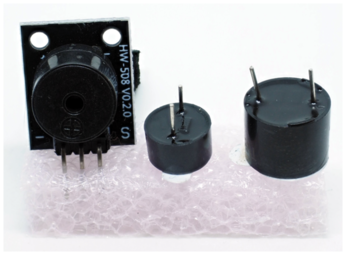Buzzer music: Simple melodies with the Pi Pico
Buzz It, Baby!

© Lead Image © writerfantast, 123RF.com
Use the buzzer to have your MCU play small wake-up melodies, signals, or music to accompany LED animations. The sound might not be a feast for the ears, but it does give your projects a great retro feel.
Every PC has at least a small beeper for signal tones. In the case of microcontrollers, you need to retrofit a buzzer to do this, but buzzers are too good for just outputting beeps. They are available for a small amount from the typical marketplaces, and you can choose between two basic types: active and passive. The active relies on a built-in oscillator to generate sound and only require two pins, while you need to feed a PWM signal to the passive. Besides voltage and earth, they require another pin for the signal.
The buzzers themselves look like small black pots with two pins (Figure 1, center and right). For active buzzers, you just need the component itself, but for passive buzzers, it makes sense to use a breakout with the required circuitry (Figure 1, left). There are also breakouts for active buzzers with three pins, but one of them is not assigned in this case. When purchasing, you can use the designation as a guide: Passive buzzers will be known as KY-006 or HW-508, while an active variant often has KY-012 in its name.
[...]
Buy this article as PDF
(incl. VAT)
Buy Linux Magazine
Subscribe to our Linux Newsletters
Find Linux and Open Source Jobs
Subscribe to our ADMIN Newsletters
Support Our Work
Linux Magazine content is made possible with support from readers like you. Please consider contributing when you’ve found an article to be beneficial.

News
-
Two New Distros Adopt Enlightenment
MX Moksha and AV Linux 25 join ranks with Bodhi Linux and embrace the Enlightenment desktop.
-
Solus Linux 4.8 Removes Python 2
Solus Linux 4.8 has been released with the latest Linux kernel, updated desktops, and a key removal.
-
Zorin OS 18 Hits over a Million Downloads
If you doubt Linux isn't gaining popularity, you only have to look at Zorin OS's download numbers.
-
TUXEDO Computers Scraps Snapdragon X1E-Based Laptop
Due to issues with a Snapdragon CPU, TUXEDO Computers has cancelled its plans to release a laptop based on this elite hardware.
-
Debian Unleashes Debian Libre Live
Debian Libre Live keeps your machine free of proprietary software.
-
Valve Announces Pending Release of Steam Machine
Shout it to the heavens: Steam Machine, powered by Linux, is set to arrive in 2026.
-
Happy Birthday, ADMIN Magazine!
ADMIN is celebrating its 15th anniversary with issue #90.
-
Another Linux Malware Discovered
Russian hackers use Hyper-V to hide malware within Linux virtual machines.
-
TUXEDO Computers Announces a New InfinityBook
TUXEDO Computers is at it again with a new InfinityBook that will meet your professional and gaming needs.
-
SUSE Dives into the Agentic AI Pool
SUSE becomes the first open source company to adopt agentic AI with SUSE Enterprise Linux 16.


